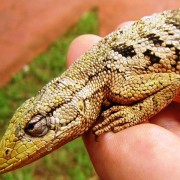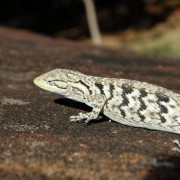Biodiversity
< Back

 Brazilian Bush Anole
Polychrus acutirostris | Spix, 1825
Brazilian Bush Anole
Polychrus acutirostris | Spix, 1825

PHOTO: Property of Native / Embrapa
Characteristics: Medium-size species measuring about 15cm in length. It has an elongated, laterally compressed body, its tail is long and prehensile, and its limbs are short. Its belly is whitish and grayish, and its back usually has black transversal stripes on it. In addition to being merged, its eyelids have small granules similar to the chameleons'.
Distribution: This species can be found from Southern Pará to Northern Argentina, including in Bolivia, Paraguay, and Uruguay.
Habitat: It lives in all types of savannas and scrublands, where there are tree-covered areas.
Habits: It is preferably diurnal and can be found in bushes and on the ground. Although it moves slowly, it can become aggressive when some predator approaches, and quickly change its color by darkening it. It usually uses its tail to support itself.
Diet: Plants and arthropods (crickets and grasshoppers, praying mantis, insect larvae, beetles and wasps).
Breeding: Oviparous, breeding occurs in the rainy season, from September to March. Each female lays 7 to 31 eggs, averaging around 18 of them. Egg incubation lasts about four months. Hatchlings are born measuring about 40mm in length and reach sexual maturity in their first year of life.
UFRA: Species spotted in Wetlands with Herbaceous Plants.










